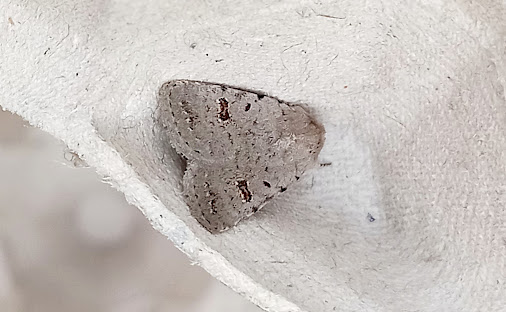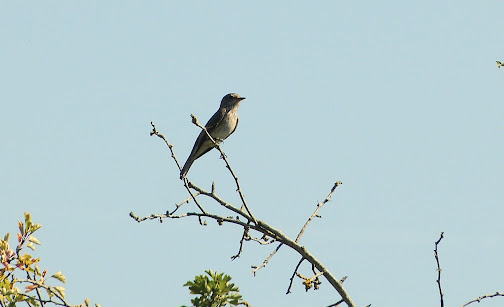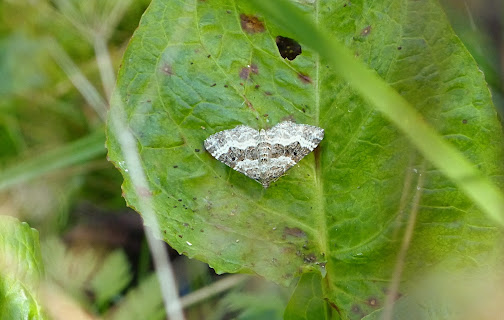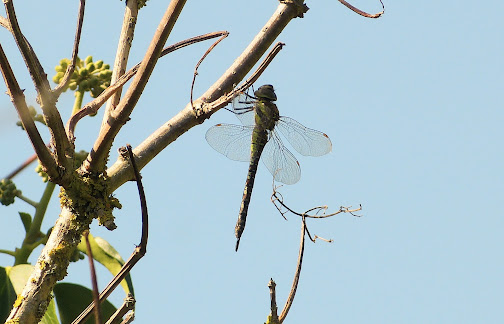Saturday 10th September 2023.
There was another bumper haul of moths at dawn this morning in and around my moth trap and after another uncomfortable nights sleep in humid conditions overnight, I kind of staggered out of bed, put the dogs out in the garden for ten minutes and consumed a grateful cup of coffee, ready to get cracking on the moths. Could there be a real goody among them like yesterday?
There were a staggering 167+ moths of 41 species recorded this morning and among them were another two more species new for the year, a Dusky Thorn and the micro moth Southern Bell (Crocidosema plebejana). Pleased with the Dusky Thorn that was perched on the wall opposite the moth box, I found a Canary-shouldered Thorn close by, my second of the year. Other notable moths included my second Dewicks Plusia of the year, a Clancy’s Rustic (not a common moth here) and another gorgeous Olive-tree Pearl. Later in the morning.
I was putting out some rubbish in one of the bins at the front of my house when I discovered a dark moth fluttering around. I did manage to pot it and it turned out to be a Bloxworth Snout! I never expected that. There were double figures on a few species this morning that included a whopping 27 Willow Beauties, 10 Pale Mottled Willow, 17 Box Tree Moths and 10 Ruddy Streaks. Among the micro moths, my second Sycamore-seed Pygmy moth was present (such a tiny yet striking moth).
I did have a laugh when I rescued a Large Yellow Underwing from a False Black Widow spider web. The Spider was about to come out and grab the moth, but I intervened and pulled the moth away from the web. However, the spider wasn't going to give up and as the moth flew off, a bit of web was stuck to both the moth and spider and the poor spiders suddenly took flight with the moth, going round and around until it released its grip and scurried back to safety. Moth 1 Spider 0!
The moths present this morning included the following:
- 27 Willow Beauty
- 1 Dusky Thorn (NFY)
- 1 Canary-shouldered Thorn
- 8 Large Yellow Underwing
- 1 Angle Shades
- 10 Pale Mottled Willow
- 1 Silver Y
- 1 Dewick’s Plusea
- 1 Riband Wave
- 7 Double-striped Pug
- 5 Marbled Beauty
- 1 Old Lady
- 1 Brimstone Moth
- 5 Lesser Yellow Underwing
- 2 Vines Rustic
- 7 Small Dusty Wave
- 4 Lime-speck Pug
- 9 Square-spot Rustic
- 1 Bloxworth Snout
- 1 White-point
- 1 Garden Carpet
- 6 L-album Wainscot
- 1 Broad-bordered Yellow Underwing
- 1 Lesser Broad-bordered Yellow Underwing
- 1 Clancy’s Rustic
- 5 Setaceous Hebrew Character
- 1 Olive-tree Pearl
- 1 Beautiful Plume
- 1 Rusty-dot Pearl
- 10 Ruddy Streak
- 1 Pellitory Cosmet
- 17 Box Tree Moth
- 1 Long-horned Flat-body
- 1 London Dowd
- 6 Narrow-winged Grey
- 1 Dark Neb
- 1 Southern Bell (NFY)
- 4 Apple Leaf Miner
- 7 Light Brown Apple Moth
- 1 Common Plume
- 1 Sycamore-seed Pygmy
While checking the moths, again there was a bit of visible migration going on (or should I say invisible, as I couldn't see anything overhead while looking up into a clear blue bright sky!). Both Yellow and Grey Wagtails were both heard going over and also a couple of Siskins too. A Willow Warbler was seen flitting about in a tree behind my garden, calling continuously.
Andy Fisher was a little worse for wear this morning and he texted me to say he was out on the lash with his working companions and will not be attending this morning's birding. However, Geoff Farwell was more than up for it as we made our way first to Posbrook Floods to see if any migrants had dropped in there. Yesterday’s news of a Wryneck in Hampshire proved fruitless and sadly, turned out to be a single observer sighting.
The small car park was full when we arrived by the Canal Path, but luckily for us, a dog walker was just leaving and so after parking up, we made our way south to view the Bridge Street Floods. Yesterday, and early this morning, a juvenile Turtle Dove had been reported on wires just north of the Ark Dog Rescue building, but all we could see were a large gathering of Feral Pigeons on the wires. On the Floods themselves, there was a flock of around a dozen Black-tailed Godwit feeding on the shallow water, but apart from an Egyptian Goose and a few Teal, not a great deal else could be seen on here. I found a Raven perched up on the bare branches of a tree over on the far side, accompanied by a Carrion Crow and several Jackdaws for size comparison. Both Geoff and I could hear it ‘cronking’ and was later seen again flying west over the reserve. A few Cetti’s Warblers could be heard calling deep within vegetation and overhead, good numbers of both Swallow and House Martins were hawking high up. A few Yellow Wagtails flew over, but like this morning in my garden, they were high up, bar one individual which I saw well.
When we reached the area overlooking Posbrook Floods, we were welcomed with a wealth of Heron species. A Great White Egret graced the main pool along with at least four Little Egrets and four Grey Herons. A sight like this, way back in the 1980’s would have been unimaginable then, but seems to be commonplace now. Incredible how things are working out in the birding world. The Canal Path held a few warblers flitting about, but proved a little difficult to pin down as they were busy feeding. This included a few Blackcaps, Willow Warblers and Chiffchaffs, but nothing more interesting than that; but a Wryneck or a Shrike could be lurking anywhere. A pair of Goldcrests were flitting about in the small Oaks overhead along with several Great and Blue Tits.
We took a walk east along a footpath overlooking the large reedbeds by the River Meon. From here, we enjoyed a couple of Stonechats searching for food by the perimeter fence and nearby scrub and Geoff thought he had a third bird, but soon recognised it as a Whinchat. Nice. Overhead, we heard the distinctive call of a Snipe and sure enough, a pair flew high northbound over the reserve. I decided to make our way back to the car and though not a great deal else was seen on the way back, it was an enjoyable walk despite the strengthening heat of the sun. Though a glorious day, it certainly was going to be a very hot day with temperatures climbing up to the 90’s!
Our next stop was to be Northney Paddocks for possibly more migrants, but getting onto Hayling Island proved difficult due to immense traffic going in the same direction. Eventually, we got to the Garage car park at Langstone and met up with both Pete Gammage and Keith Turner, who were just leaving the area. After picking up some lunch from the garage and a good chat with the guys, we made our way down the footpath to the Paddocks. From here, we came across at least 3 Spotted Flycatchers hawking for insects and they performed superbly for us in the bright sunshine.
A few Chiffchaffs were also seen and 3 female / juvenile Sparrowhawks were flying together around the tall Poplar trees, upsetting the local bird life below them. A Common Buzzard could be seen distantly high up above the Sparrowhawks and a male Kestrel flew low over one of the paddocks to land in one of the Poplar Trees. A few Yellow Wagtails could be heard flying overhead, though none were actually seen. A little later, after watching several Migrant Hawker dragonflies going up and down the footpaths in search of prey, we bumped into John Cronin, who was out for a walk with his binoculars and so we had a good chat with him before we departed for home. Again, I had a few household chores to do at home and so I dropped Geoff off and made my way back to Southsea.
Geoff, later in the afternoon, went to Pigeon House Farm Lane where he recorded the following sightings: 75+ Yellow Wagtail, 6 Whinchat, 2 Stonechat, 8 Chiffchaff, 3 Whitethroat, 2 Buzzards and a Sparrowhawk.


























No comments:
Post a Comment